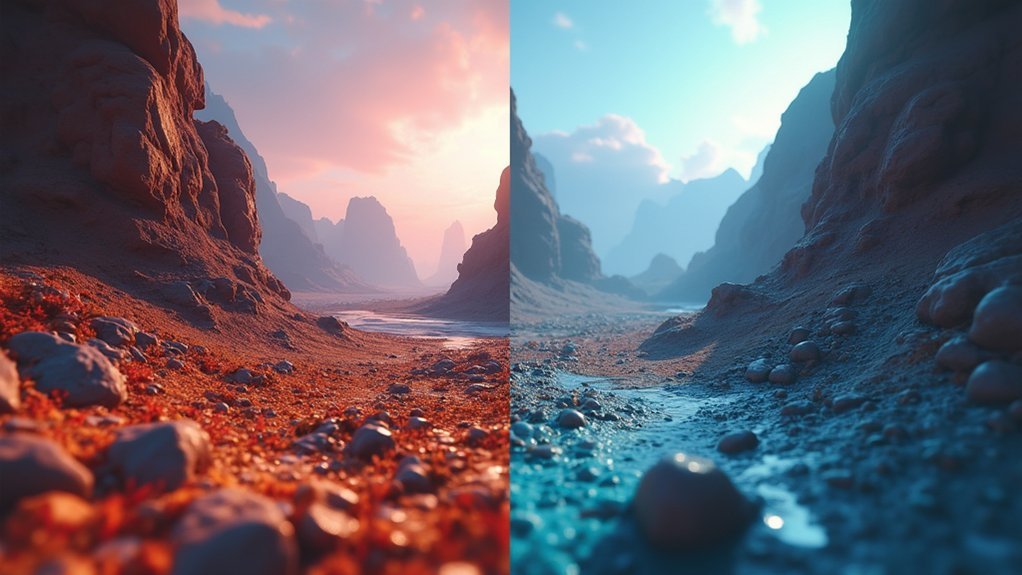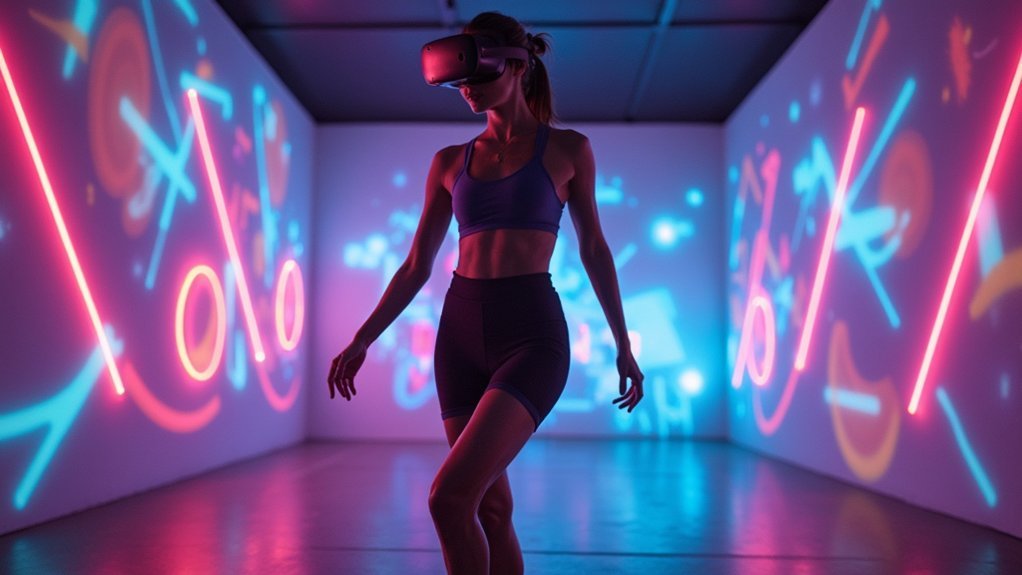You’ll experience dramatically superior lighting and atmospheric effects with PCVR, including volumetric fog, dynamic shadows, and realistic fire that Quest’s mobile chipset simply can’t handle. PCVR delivers razor-sharp textures at 5760 x 2880 resolution compared to Quest’s noticeably blurred visuals with heavy aliasing. Environmental immersion differs drastically too – PCVR environments feel alive with weather effects and dynamic elements while Quest versions appear static and lifeless. Understanding these differences helps you choose the platform that’ll transform your virtual adventures.
Lighting and Atmospheric Effects Quality

When you compare the lighting systems between PCVR and standalone Quest versions of “Alien Rogue Incursion,” you’ll immediately notice the PCVR version’s advanced volumetric and dynamic lighting effects that create greatly enhanced visual depth and realism.
These sophisticated lighting techniques make environments feel alive and immersive, casting realistic shadows and illumination that responds naturally to your movements.
The Quest version can’t match this quality, delivering flatter visuals that lack the same atmospheric impact.
The Quest version delivers compromised visuals with reduced atmospheric depth compared to its PCVR counterpart.
You’ll miss vital atmospheric elements like detailed fog, steam, and realistic fire effects that make the PCVR experience so compelling.
Weather effects and environmental dynamics are noticeably absent in the standalone version, creating a less engaging atmosphere that doesn’t capture the rich, immersive setting you’d experience on PCVR.
Texture Sharpness and Detail Resolution
The texture quality difference between PCVR and standalone Quest versions of “Alien Rogue Incursion” becomes strikingly apparent the moment you examine any surface detail.
You’ll notice sharp, crisp textures in PCVR that render at an impressive 5760 x 2880 pixels, delivering exceptional texture sharpness that makes every environmental element pop with clarity.
In contrast, the Quest version disappoints with noticeable blurriness and aliasing effects that diminish immersion.
When you’re experiencing Virtual Reality at high resolutions, these details matter considerably.
The PC version’s superior hardware allows intricate surface textures to shine, while the Quest’s mobile chipset limitations result in reduced detail resolution.
You’ll find yourself constantly comparing the two platforms, as the graphical restrictions create a substantially diminished visual experience on standalone hardware.
Environmental Immersion and Visual Depth

Beyond surface-level texture differences, you’ll discover that environmental immersion separates PCVR from standalone VR more dramatically than any other visual aspect.
When you’re exploring Alien Rogue Incursion’s environments, PCVR delivers superior volumetric and dynamic lighting that creates genuine visual depth throughout each scene. You’ll notice atmospheric elements like fog, steam, and realistic fire effects that make environments feel alive and dynamic, while standalone versions appear static and lifeless.
Weather effects and intricate lighting systems in PCVR enhance environmental immersion by creating realistic shadows and illumination that respond naturally to your movements.
The standalone version can’t replicate these sophisticated rendering techniques, resulting in flat, unconvincing environments that break immersion. This dramatic difference in environmental quality makes PCVR the clear winner for players seeking truly enchanting visual experiences.
Frequently Asked Questions
Is Pcvr Better Quality?
You’ll get superior visual quality with PCVR compared to standalone headsets. You’re looking at higher resolutions, sharper textures, advanced lighting effects, and better atmospheric details that aren’t possible on mobile chipsets.
Is PCVR or Standalone Better?
You’ll find PCVR delivers superior overall quality with better visuals, larger game libraries, and more immersive experiences. However, standalone headsets offer greater convenience, portability, and affordability for casual users.
What’s the Difference Between VR and PCVR?
VR’s the broad term for immersive digital experiences using headsets. PCVR specifically means you’re connecting your headset to a gaming PC, which gives you much better graphics, higher resolutions, and more powerful performance than standalone devices.
Is Pistol Whip on Quest 3 or PCVR?
You can play Pistol Whip on both Quest 3 standalone and PCVR. You’ll get portable convenience with Quest 3, while PCVR delivers superior graphics and enhanced visual effects for better immersion.





Leave a Reply